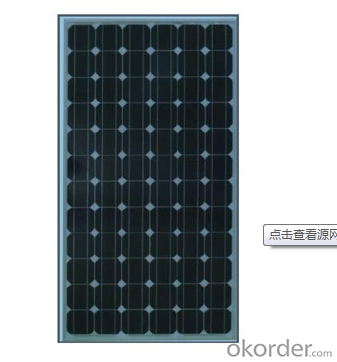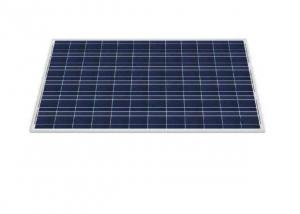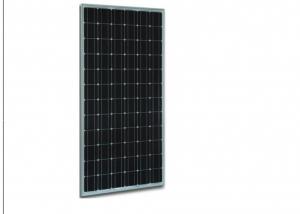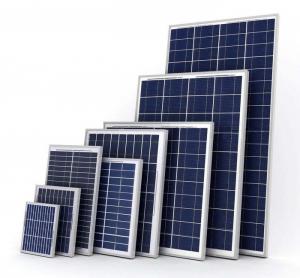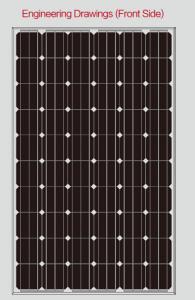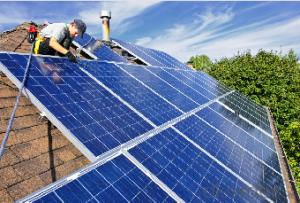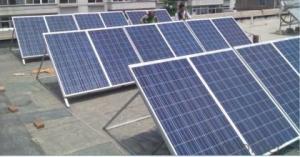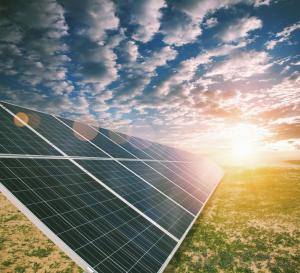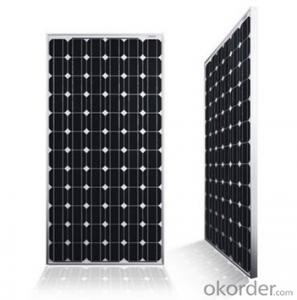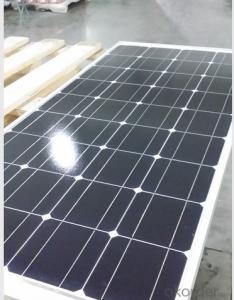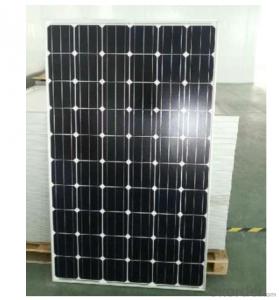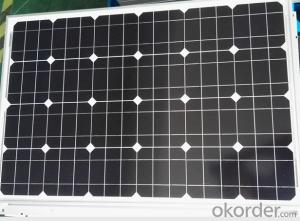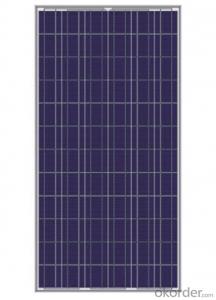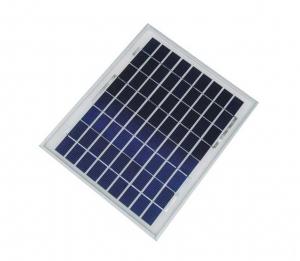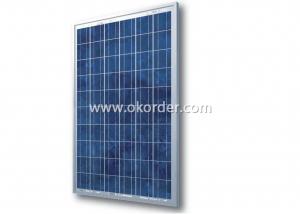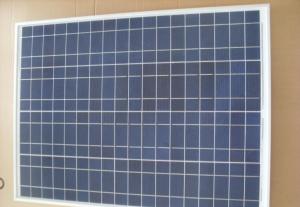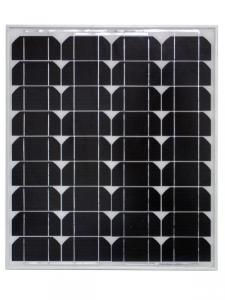Fs 22 Solar Panels - Monocrystalline CNPV-325W High Performance 72 Cell
- Loading Port:
- Shanghai
- Payment Terms:
- TT OR LC
- Min Order Qty:
- 25 pc
- Supply Capability:
- 100000 pc/month
OKorder Service Pledge
OKorder Financial Service
You Might Also Like
Product Description:
Solar Monocrystalline Series Panels
Introduction of Solar Monocrystalline Series Panels
CNBM Solar photovoltaic (PV) Panel is designed for large electrical power requirements. It is the optimal choice for both on-grid and off-grid power systems. CNBM Solar panel offers high performance of power per square foot of solar array. Monocrystalline silicon(c-Si): often made using the Czochralski process. Single-crystal wafer cells tend to be expensive, and because they are cut from cylindrical ingots, do not completely cover a square solar cell module without a substantial waste of refined silicon. Hence most c-Si panels have uncovered gaps at the four corners of the cells.
Standard Test Conditions of Solar Monocrystalline Series Panels
The opto-electrical specifications shown below are stabilized values being measured at Standard Test Conditions, Irradiance: 1000W/m2, Spectrum: AM1.5 at 25°C, The info below is subject to manufacturing tolerances. Where appropriate minutes of measurement are available and are used for the dimensioning of the installation.
Advantages of Solar Monocrystalline Series Panels
• Solar performance guarantees for 25 years
• 12 years guarantee for workmanship
• Timeliness of delivery
Characteristics of Solar Monocrystalline Series Panels
Max Power Voltage Vmp (V) | 37.6V |
Max Power Current Imp (A) | 8.65A |
Open Circuit Voltage Voc (V) | 46.1V |
Short Circuit Current Isc (A) | 9.2A |
Max Power Pm (W) | 325W |
Temperature Coefficient of Cells
NOCT | 47℃±2℃ |
Temperature Coefficients of Isc (%/℃) | 0.064 |
Temperature Coefficients of Voc (%/℃) | -0.33 |
Temperature Coefficients of Pmp (%/℃) | -0.45 |
Mechanical Data Solar Monocrystalline Series
Power | 325W |
Dimension | 1965×992×35mm |
Weight | 18kg |
Tolerance | ±3% |
The dimension of the modules can be changed according to the demand of clients
Limits
Operating Temperature | –40 °C to +85°C |
Storage Temperature | –40 °C to +85°C |
Max System Voltage | 700V |
Guarantee Solar Monocrystalline Series Panels
Products Guarantee | 12 yrs free from defects in materials and workmanship |
Performance Guarantee | No less than 90% within 10yrs and no less than 80% within 25yrs |
Certificates | UL, IEC, ISO, TUV, CE |
The Examination of Solar Monocrystalline Series Panels
FAQ
We have organized several common questions for our clients,may help you sincerely:
①What price for each watt?
It depends on the quantity, delivery date and payment terms,
②What is your size for each module? Can you tell me the Parameter of your module?
We have different series of panels in different output, both c-Si and a-Si. Please take the specification sheet for your reference.
③Can you provide the peripheral products of the solar panels, such as the battery, controller, and inverter? If so, can you tell me how do they match each other?
Yes, we can, we have two companies for solar region, one is CNBM International, the other is CNBM engineering Co.
We can provide you not only the solar module but also the off grid solar system, we can also provide you service with on grid plant.
④What is your warranty system?
Our product performance guarantees for 25 years
• 12 years guarantee for workmanship
• Timeliness of delivery
• Quality Products certified (TÜV, UL, CE, ISO)
- Q: ASAP :) as much details as possible
- As other sources of energy become more expensive due to declining rates of production, or increased costs for safety or pollution controls, solar energy becomes more practical as a method of gathering inexpensive supplemental energy. Look at the german experiment, where rooftops in germany were covered in solar panels and wired into the house system to supplement energy needs. In some places, I'm not sure about Germany, you can actually sell back surplus electrical energy to the power company if you have more capacity than you can store in the batteries attached to the panels. Keeping energy costs lower than they would otherwise be helps the economy by making growth less difficult for new and existing companies, and puts money in the hands of consumers that they otherwise would have had to spend on electricity. We need some additional innovations in battery technology and solar panels to make solar a mainstream source of energy, but replacing roofing with solar panels is a very interesting idea that might become a mainstream building practice if the cost of other kinds of energy keeps rising.
- Q: if car companies install solar panels on cars, like in all the car were the sun can reach that would reduce the consumption of gas in the summer, and might save some energy for winter and if that energy is not enough they can use gas or electricity i think that would be a lot of savings, and less contamination i don't know that is my idea what do you people think?
- There okorder Part of the problem of putting solar panels on a vehicle is that at almost no time is the orientation for the panels correct. You would not consider putting solar panels on the shady side of your house, or not tilted and aimed properly. This is because solar panels are expensive and you would like to make sure that they are as efficient as possible. A better plan may be to put solar panels on your house and buy an electric car. Have the panels feed power into the grid during the day where you can be paid at the higher daytime rates and then charge your vehicle at the lower night time rates from the grid.
- Q: i attached a usb charger to my solar panel(it has an output of about .2 volts) but i read on my multimeter its only using about 8 volts however on the conventional wall charger that i use to charge it has an output of about 5. volts.... i believe that my mp3 player is not charging it does not display the charging icon when it is on or off ....is this becuase the output is higher ? do i need to install a volt dropping diode to prevent it from putting to much energy at once? (my mp3 charges fine on the wall charger but does not seem to respond to the solar panel so it the circuits are fine....)
- 5.3V is the open voltage or? So the full wattage of the photograph voltaic panel is 45W or so? i assume you are able to no longer make all your small A/C home equipment into DC ones. so which you would be able to think of bearing directly to the 2V DC enter 00W inverter. this type of inverter might have a some bit extensive enter voltage variety from like V-20V some situations.
- Q: I am moving to Hawaii and the house we are living in has independent electricity. (solar panels and gas powered generators.)
- Guide okorder /
- Q: Can solar panels be used on boats or marine applications?
- Yes, solar panels can be used on boats or marine applications. In fact, they are becoming increasingly popular for providing renewable energy on board boats, yachts, and other marine vessels. Solar panels can generate electricity to power various onboard systems, including navigation equipment, lighting, refrigeration, and charging batteries. They are a sustainable and efficient way to harness solar energy while minimizing reliance on traditional fuel sources.
- Q: hi so im doing a school project thing and they have a lot of different questions for us that help us decide whether we would rather a city have a nuclear reactor, or solar panel. But i cant seem to get the last 2 questions...help please???so question ........What types of emissions, if any, are produced by each type of generating station? Do these emissions affect human health?question 2.....What are the long term financial costs associated with maintaining each type of generating station?thanks!
- There's no standard nuclear reactor, but if we take a GW nuclear plant, it can generate about 8 terawatt-hours/year. A 200 watt solar panel can generate about kilowatt- hour/day, or 365 kwh/year, so that's about 2 million 200 watt solar panels. However, the power output from the nuclear plant is controllable by the operators, where solar panels only operate at full output for a few hours/day (on clear days - less if there's cloud). Therefore, to compare the two, you have to factor in some kind of energy storage or backup which will increase the cost of the solar installation (perhaps by a factor of two or more). Despite claims of solar being cheaper than coal now, when one compares apples to apples (i. e. total energy produced, and controllability) solar is still several times more expensive than coal, and about twice as expensive as nuclear even in the U. S. A gram of U-235 can make usable energy equal to three metric tons of coal. Solar energy production has no hazardous by-products, but manufacture of the panels can involve some very hazardous materials like fluorine (for silicon panels) or cadmium (for CdTe panels). This is part of the reason panel manufacture has gone to Asia - they have fewer environmental regulations and it's easier to dispose of the byproducts of production. DK
- Q: hi, i got a pond and i am planning of putting some lights on it during night time. but i want to use solar panels and i have done a bit of research about solar panels and i know how they work, i know that the common voltage to use is 2v so you can use car batteries or deep cycle batteries, but my question is:. what wattage of bulb can you recommend2. how long it would take to drain my battery (can i have it overnight)3. and what wattage of solar panel should i get enough to recharge my battery the next day.hope anyone can help..thanks
- You can get 6V cells and SLA batteries. You would get a panel and batteries suitable for the lights you get though. Depending on what you want to do, you shoud look into LED lighting, which is more efficient than incandescent. You do not want to drain your battery flat. Rather you want to draw only 2/3 of its capacity of so. You would find the lights you want (likely 2VDC), and add up the current they draw, and get a battery that would supply enough capacity (in AH, which is amps time hours) for a couple nights use (to account for weak solar days), and a solar panel to charge two days of use in one good day. You would use a charge controller so that the solar panel does not over charge the battery, and some sort of dusk timer to turn your lights on at dusk and off several hours later.
- Q: How do I clean my solar panels?
- To clean your solar panels, start by checking the manufacturer's instructions as some panels may have specific cleaning requirements. Generally, you can clean them by gently rinsing with water using a hose or a bucket and sponge. Avoid using abrasive materials or harsh chemicals that could damage the panels. If there's stubborn dirt or debris, you can use a mild soap solution with a soft brush to gently scrub the surface. Regularly cleaning your solar panels will help to maintain their efficiency and ensure optimal energy production.
- Q: i'm making a small solar panel powered fan but it cant run the cellphone vibration motor even i have place two x2 solar panel.
- this type of solar panel has some few watts. Ah is a quantity (which represent energy) that define the flow of ampere for a period of hour. so, the max instant electric current is 40mA and the max power is 40mA x 3.6 = 0.44 watts but, this value depends of the solar ilumination which the panel is subjected.
Send your message to us
Fs 22 Solar Panels - Monocrystalline CNPV-325W High Performance 72 Cell
- Loading Port:
- Shanghai
- Payment Terms:
- TT OR LC
- Min Order Qty:
- 25 pc
- Supply Capability:
- 100000 pc/month
OKorder Service Pledge
OKorder Financial Service
Similar products
Hot products
Hot Searches
Related keywords



